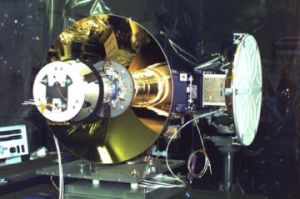Jul 2 2014
This month, Oxford scientists are celebrating ten years of scientific exploration by the Cassini-Huygens mission, a joint NASA-ESA ‘flagship’ mission to explore the gas giant Saturn, its rings and diverse satellite system.
Cassini has revealed many wonders in the outer solar system, from the hydrocarbon seas of Titan to the erupting plumes of Enceladus and the swirling storms of Saturn, and more is still to come as this sophisticated robotic spacecraft continues its lonely orbits a billion kilometres from home.
 The CIRS instrument, with Oxford’s cooler on the right hand side.
The CIRS instrument, with Oxford’s cooler on the right hand side.
Researchers from Oxford’s Atmospheric, Oceanic and Planetary Physics sub-department have been part of the Cassini mission since the late 1980s, when work began to develop hardware components for the Composite Infrared Spectrometer (CIRS) in partnership with NASA’s Goddard Spaceflight Center. CIRS is an interferometer, a sensitive device that measures the spectrum of infrared light emitted from planetary atmospheres and surfaces, providing precise measurements of their temperatures and composition. Through the early 1990s, Oxford’s planetary experiments group contributed to the instrument design and fabrication, including a cooler to maintain the low-temperatures needed to detect the weak infrared emission from bodies in the Saturn system, and the assembly to hold the detectors that make up the focal plane. The engineering models for these systems are still held at Oxford Physics, compared with their counterparts mounted on the spacecraft in the frigid outer solar system. Today, Oxford’s planetary group continues to provide CIRS observation planning and operations support; hosts the UK data mirror for processing of the returned data; and takes a leading role in the scientific analysis of the infrared observations.
Cassini-Huygens launched in 1997, and after a seven-year cruise (visiting Venus and Jupiter along the way) arrived in Saturn orbit on July 1st 2004 for a nominal mission lifetime of 4 years. As a testament to the robust engineering and design of the Cassini hardware, CIRS is still going strong a decade later, providing Oxford researchers with a unique opportunity to explore the workings of a giant planet. Furthermore, the longevity of the mission has allowed scientists to monitor evolving atmospheric conditions with season, as Saturn has moved from the depths of northern winter in 2004 into the northern spring sunlight of 2014 (Saturn takes 30-earth years to orbit the Sun, so Cassini has been observing for a third of a Saturnian year). By the end of the mission in 2017, Saturn will have reached the northern summer solstice, allowing it to study the giant planet system during every season.
Oxford’s planetary data analysis group has developed a suite of sophisticated software tools to interpret the CIRS observations, allowing a reconstruction of the three-dimensional atmospheric temperature and composition of Saturn and Titan. The data interpretation relies on precise laboratory measurements of gaseous spectra from Oxford’s planetary spectroscopy facility, allowing individual gases to be identified by their unique fingerprints. By combining these tools, Oxford scientists have revealed Saturn’s seasonally evolving temperatures, including the discovery of hot polar cyclones churning at both poles of Saturn; a bizarre hexagonal wave encircling Saturn’s north pole; and tracked the eruption of an enormous storm system in 2010-11 that spawned a gigantic (but short-lived) vortex in Saturn’s stratosphere (nicknamed the ‘beacon’). On Titan, Oxford researchers have studied the dynamics and meteorology of the intense north polar winter vortex, and the forming south polar vortex as the southern hemisphere descends into winter darkness. The atmospheric dynamics of these alien worlds have been simulated by Oxford’s Geophysical Fluid Dynamics group, both numerically using sophisticated general circulation models (GCMs) and in the laboratory using rotating fluid experiments. One such laboratory experiment was able to reproduce the six-sided hexagonal wave present at Saturn’s north pole.
Oxford’s involvement in Cassini and the CIRS experiment has provided doctoral training to many students who have earned their PhDs as part of this project, and employed several postdocs that have gone on to become experts in their fields. Today, Oxford’s planetary science group continues to look ahead to future missions exploring our Solar System and studying the extreme climates of planets around other stars, but Cassini has proven the most successful and long-lived of these endeavours. When the mission finally ends in 2017, burning up in the atmosphere of Saturn, it will rightly be remembered as the most successful outer solar system mission in our history, and as Oxford’s most distant planetary hardware to date.